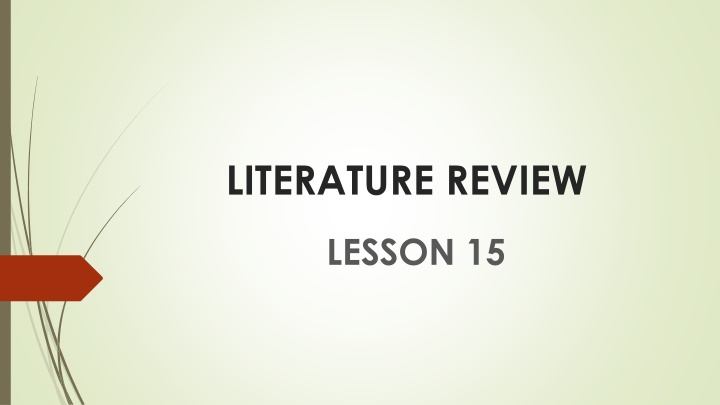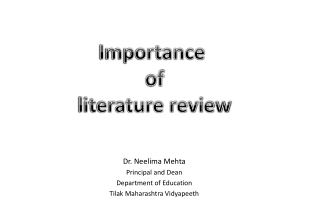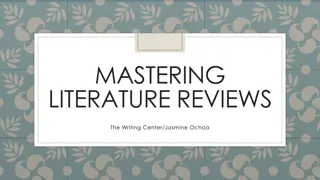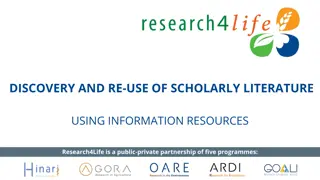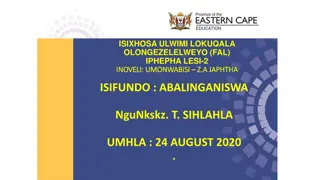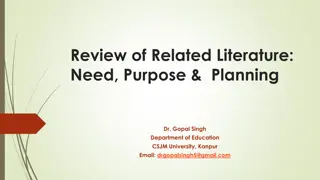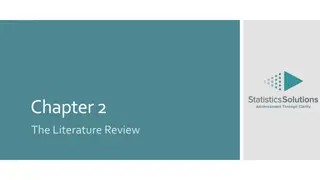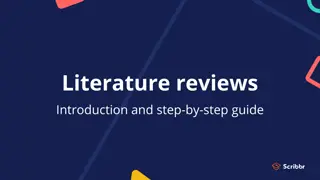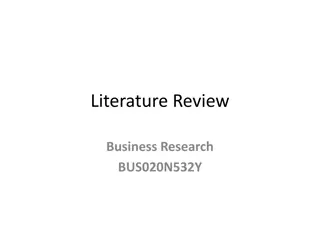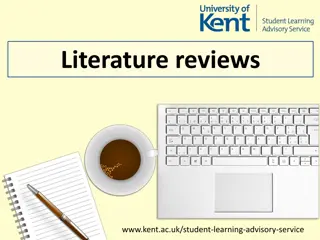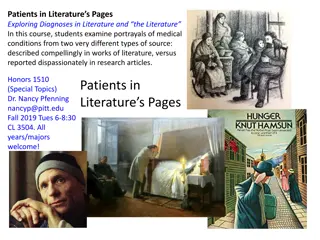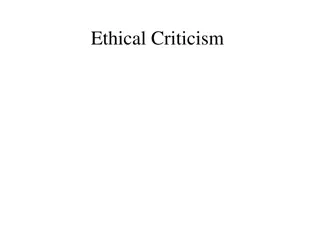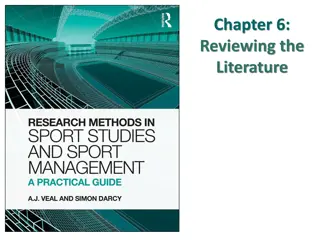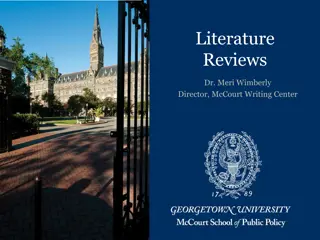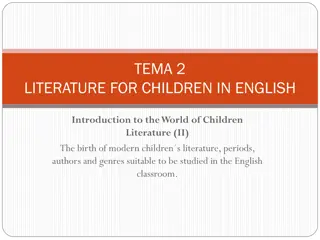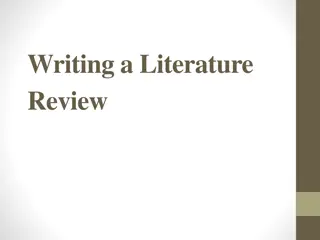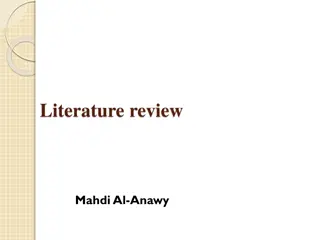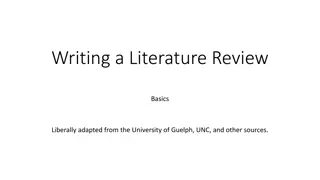LITERATURE REVIEW
Reviewing literature is a crucial aspect of research projects, allowing for a theoretical foundation and connection to practical applications. Steps involved include sourcing, careful reading, note-taking, theme identification, drafting, and revising. Discussions with colleagues can enhance the understanding and application of literature review in academic endeavors.
Download Presentation

Please find below an Image/Link to download the presentation.
The content on the website is provided AS IS for your information and personal use only. It may not be sold, licensed, or shared on other websites without obtaining consent from the author.If you encounter any issues during the download, it is possible that the publisher has removed the file from their server.
You are allowed to download the files provided on this website for personal or commercial use, subject to the condition that they are used lawfully. All files are the property of their respective owners.
The content on the website is provided AS IS for your information and personal use only. It may not be sold, licensed, or shared on other websites without obtaining consent from the author.
E N D
Presentation Transcript
LITERATURE REVIEW LESSON 15
Basic understanding of reviewing literature A review of the literature contains an examination and description of journal articles, Internet information, books, and other sources related to a particular topic. The literature review sets your topic in a theoretical context. A review of the literature enables you to connect education theory directly to your classroom practice. The number of sources used in a literature review is determined by your research topic and the type of research you are conducting. Some action research projects do not require a literature review. A review of the literature can be included at the beginning or the end of the action research report. Read more about general understanding on Literature Review in the Supplementary Reading-1 Johnson, A. (2012). A short guide to action research (4th ed.). Allyn and Bacon.
Activity -1: Discuss the questions with your colleagues What is the literature review? What is the purpose of the literature review? Do teachers need to review literature in their action research? Where do we place the literature review in the action research report? What sources do teachers use for the literature review? How many sources do teachers use for the literature review? Read more about general understanding on Literature Review in the Supplementary Reading-1 Johnson, A. (2012). A short guide to action research (4th ed.). Allyn and Bacon.
Steps of Literature Review The steps in creating a literature review are to 1. Find a good college library, 2. Locate possible sources, 3. Read your sources carefully, 4. Read and take careful notes, 5. Organize notes and look for emerging themes, 6. Express emerging themes with declarative sentences, 7. Create an extremely rough draft, 8. Start the revision process, and 9. Edit. Read more about Steps of Literature Review in the Supplementary Reading-2 Johnson, A. (2012). A short guide to action research (4th ed.). Allyn and Bacon.
Activity-2: Discuss the questions with your colleagues What is the action research question in the sample note in Step-4: taking notes? How many notes are emerged in each source in Step-4? What and how many themes are emerged out of the notes? How are the emerging themes expressed in declarative sentences? Study carefully how the emerging themes are written into the first draft of Literature Review.
Activity-2: Answer key What is the action research question in the sample note in Step-4: taking notes? What are the characteristics of effective field experiences in a teacher education program? How many notes are emerged in each source in Step-4? Guyton, E. & McIntyre, D. J. (1990). ----- 3 notes Zeichner, K. (2008). ------ 3 notes McIntyre, D. J., Byrd, D. M., and Foxx, S. M. (1996). ------ 5 notes Cochran-Smith, M. & Zeichner, K. (2005). ----- 2 notes Grossman, P. (2005). ----- 4 notes Darling-Hammond, L (2006). ----- 3 notes
Activity-2: Answer key What and how many themes are emerged out of the notes? CF congruence between campus experience and field experience PG field experience linked to program goals CC = field linked to course components How are the emerging themes expressed in declarative sentences? There should be congruence between campus and field experiences (CS-05, G-05, GM-90). Field experiences should reflect or be linked to the goals of the teacher preparation programs (DH-06, GM-90). Knowledge and skills in college courses should be linked to what happens in field experiences (CS-05, DH-06, D-04, MBF-96, 7-08).
Citations The use of citations within your literature review supports your ideas and sets them in a theoretical context. citations (a)lend credibility to your writing, (b)acknowledge the authors, and (c)enable the reader to find your supporting documents. (d)various types of material in the body of your work can be cited according to the sixth edition and seventh edition of the American Psychological Association s Publication Manual (APA). Read more about Citations in the Supplementary Reading-3 Johnson, A. (2012). A short guide to action research (4th ed.). Allyn and Bacon.
References Any source used in your literature review must be listed fully on the reference page. This informs readers as to what sources were used and allows them to locate these sources if necessary. The Supplementary reading-3 describes how the following sources are referenced into reference page. Journals: Journal Articles with One Author. Journal Articles with a Colon in the Title. Journal Articles with More than One Author. Books: Books with One Author. Books with a Colon in the Title. Books with Many Authors. Books of a Later Edition. An Edition Book: A Chapter in an Edited Book with One Editor. A Chapter in an Edited Book with More than One Editor. Read more about References in the Supplementary Reading-3 Johnson, A. (2012). A short guide to action research (4th ed.). Allyn and Bacon.
Activity-3: Study carefully the supplementary readings-3 Study carefully how books and research articles are cited in Literature Review. Study carefully how books, research articles, and edited books are cited in Reference page.
Activity-4: Sample literature reviews Read the sample literature review at the beginning of the action research report-1 and the sample literature review at the end of the action research report-2 and answer the questions. How many sources are used in the Literature reviews respectively? How many themes are emerged in the Literature review respectively? How many sources are listed in the Reference page respectively? Source: Johnson, A. (2012). A short guide to action research (4th ed.). Allyn and Bacon.
Activity 5: Do the activity individually or in pairs. 1. Find a topic you are interested in as a possible action research project. Find one journal article that contains a review of relevant literature at the beginning. What do you notice about the style of writing? 2. Using a topic that interests you, find and list one of each kind of the following sources: journal article, Internet website, and book. 3. Find an example of an article in an academic journal that has a well-written literature review. Describe at least three things the author does well. 4. Use ERIC to find articles related to an area of interest. Source: Johnson, A. (2012). A short guide to action research (4th ed.). Allyn and Bacon.
THANK YOU FOR YOUR ATTENTION
